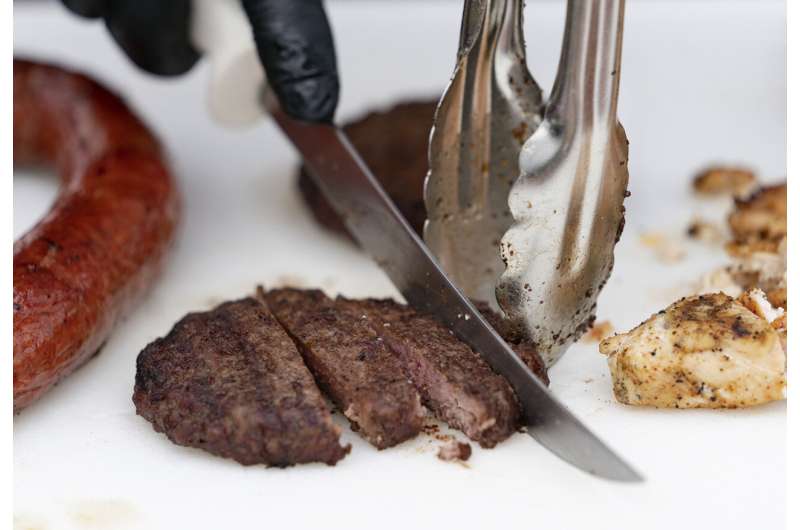This article has been reviewed according to Science X's editorial process and policies. Editors have highlighted the following attributes while ensuring the content's credibility:
fact-checked
trusted source
proofread
Mouthfeel of food determines whether people go back for seconds

Are you a sucker, cruncher or chewer … maybe even a smoosher? Think about it: how do you taste your food?
Texture has been one of the trends in food product messaging for several years, said Rhonda Miller, Ph.D., Texas A&M AgriLife Research Faculty Fellow and meat science professor in the Texas A&M College of Agriculture and Life Sciences Department of Animal Science in Bryan-College Station.
Miller is applying her mouthfeel research to products in the beef industry to determine how to improve consumption. She conducted a three-phase Mouth Behavior Study involving how all four types of eaters consume beef and steak.
People manipulate food in their mouths differently—some use their molars and chew; some people manipulate the food with their tongue. Chewers and crunchers like to use their teeth to break down foods. Suckers and smooshers manipulate food between their tongue and the roof of their mouth.
But these texture terms are not universally understood—a "good crunch" to a cruncher is much different to a chewer.
"Most people don't even realize they are manipulating their food in their mouth," Miller said.
But Miller does, as she operates the Sensory Science Evaluation Laboratory, conducting research on a variety of meat and food products, evaluating them for flavor and palatability.
The science of mouthfeel
Little is known about what drives people's preferences, but everyone is born with a preference for texture, Miller said. Texture is a strong driver of rejection of a food item. Researchers are interested in whether texture impacts purchasing habits regarding food products.
"In general, people have a very low texture awareness," she said. "They talk about flavor, but not texture, because we have a low awareness of how to verbalize that."
Miller breaks down the mouthfeels a little more: chewers and crunchers have the same mouth motions, but chewers are less vigorous in their chew and eat food more slowly, while crunchers eat food forcefully. Crunchers are often accused by others of being too loud. They crunch until the food is gone. Smooshers use their tongue and the roof of their mouth; suckers appropriately suck the flavor out before chewing.
She said the U.S. population consists of about 8% suckers, 43% chewers, 33% crunchers and 16% smooshers. The study also showed that suckers reject products at a 45% level, while smooshers reject at 29%, crunchers at 16%, and chewers at 10%.
Her study revealed that many times, products are made without considering consumers' sensory behaviors.
"But we know there are some that are: for instance, granola bars—do you want them crunchy or chewy? You can look at the package merchandising and see they know there is a difference in what their consumer wants," she said.
"So as meat scientists, our concern is, especially when beef prices are high, retailers want to know how they can get consumers to buy beef one more time a month," Miller said.
Applying the science to beef
Miller found interesting differences in the way chewers, crunchers, smooshers and suckers experience hamburgers and steaks based on the way the meat was processed prior to cooking.
Ground beef burger patties were rated on descriptive textures such as surface roughness, firmness, connective tissue amount, cohesive mass, particle size and chewiness. Consumers identified factors that influenced their evaluation.
- Chewers must have flavorful burgers, no soggy buns, no rubbery feel or gristle, and the patty can't be dry or too greasy.
- Crunchers want a burger that is not too dry or raw, not chewy, crumbly or chunky, no soggy bun and the meat can't stick to their teeth.
- Smooshers want a juicy, well-seasoned patty, no gristle, not congealed or sludgy and no residue feel in their mouth.
- Suckers defined their ideal burger as juicy, not too chewy, but not crumbly, and the seasoning should come before cooking.
The goal of this study was to determine how fat content affected consumers' perceptions. Chewers and smooshers found higher-fat patties less tough and chewy, with crunchers saying 93% lean beef was too dry. Higher fat was associated with higher tenderness. For the suckers, it wasn't about fat content, but rather whether the meat was chopped or ground.
The verdict on chopped beef patties—chewers said lean chopped patties were tougher, crunchers said they were less juicy, smooshers said they were greasy, and suckers said they were dry. The final outcome was that ground beef patties from the chuck are less polarizing across the mouth behavior groups compared to ground beef patties made from other lean sources.
"We learned a lot, and I walked away with an 'aha' moment," Miller said. "The ideal patty is easy to bite and stays together well. Also, we learned that chewers do not like McDonalds."
When it came to steaks, the higher-marbled steaks were liked by consumers across each mouth behavior group, but for different reasons. The aging process produces big gaps among mouth behaviors.
"We've been a little stale in how we as meat scientists think," Miller said. "This study has helped me think outside of the box—but I don't have any definitive answers yet."
Provided by Texas A&M University




















